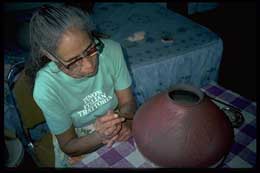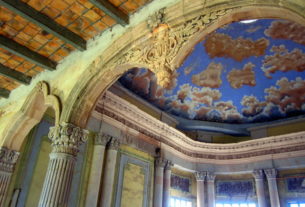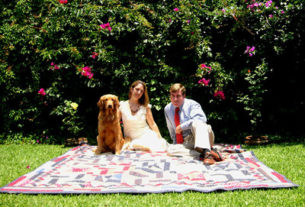Juan Mata Ortíz is a small village of potters, farmers and cowboys in Northern Chihuahua. About 30 years ago, an unschooled artistic genius, Juan Quezada, taught himself how to make ollas, earthenware jars, by a method used hundreds of years ago by the prehistoric inhabitants. Now, his works are known worldwide and over 300 men, women and children in the village of less than 2,000 make decorative wares. Much of the polychrome and blackware is feather light and exquisitely painted.
Many of the potters are also cowboys and farmers. These stories serve to document the art and the people in this unassuming pueblo, an art that is often called “magical” by the relative handful of tourists who visit. Enjoy this other view of Mexico.
About nine years ago, there weren’t many tourists in Mata Ortíz, especially during the summer. Occasionally however, a vehicle would slowly bounce its way around the unpaved streets, trailing a tail of dust. Encumbered by cameras, notebooks and a small tape recorder one day, I was walking over to interview Consolación Quezada when I saw a carload of tourists slowly heading my way. I waited for them, anticipating they would be looking for potters and would stop when they saw a Gringo face. They did, and I directed them to park and come with me.

We arrived moments later and she greeted us in her usual warm manner. Consolación is an elegant lady in her own humble way and when she graces you with a smile, you are just glad to be alive. (Read more about her by clicking here).
My charges didn’t speak any Spanish. Curiously, after viewing her unique black-on-redware, they didn’t ask me to translate as they asked prices. Instead, they just said to her in English, “How much?” Ever prepared, Consolación wrote her price on the page of a notebook: $70.00. One of the visitors took the notebook and pencil, crossed out the price, wrote “$35.00” and handed it back. My friend frowned in apparent confusion, stroked a line through the lower amount, wrote something and handed it back. “$70.00.”
“Hmm,” the buyer said. “Guess she doesn’t bargain.”
“Nope,” I opined. They ended up buying the earthenware for the original price and got a great deal. She no longer paints in that style as her special red paint source has dried up.
Another time, I was approached by some tourists who wondered if there were accommodations in the village. I pointed out the Posada de las Ollas, saying it was a little inn just down the street. I encountered them a few minutes later at the Posada as they were unloading some empty boxes that would undoubtedly soon be filled with pottery. Knowing they didn’t yet understand that I was involved with the inn, I inquired about the room tariff. Was it to their liking?
“Oh, we didn’t ask,” one of the gentlemen replied. “We’ll negotiate it later. They (meaning Mexicans) will be insulted if we don’t negotiate the price. They expect it.”
I wonder why so many First World tourists feel that Third World vendors insist on negotiations. Do you think an artisan in Mexico, Peru, Papua New Guinea or Thailand would be insulted if a tourist agreed to pay $100.00 for some trinket? I don’t think so.
Bargaining can be fun, however, for both sides–but we need to keep in mind how much we are bargaining for. A first price offer in a high profile tourist centre such as Tijuana will probably be outlandish. That is very different from the first price offer for a back-strap loom-woven friendship bracelet in a small central or southern Mexican village. The difference in the first offer and the final settlement may only be fifty cents. Negotiating for pennies is demeaning for the vendor and for the potential buyer. Remember, the tourist has paid hundreds or thousands of dollars for the vacation experience. The vender is working to pay for that night’s meal.
Tourists driving down the prices in San Jalietza, Oaxaca became so bad in the 1980s that the weavers were selling for less than cost just to be able to put beans on the table for their children that day. A service club from Oaxaca City stepped in and convinced the weavers to form an association. A plaza where all sales would take place was built, fair prices were established and tourists were told, “No negotiations, the prices are set.”
Fortunately, bargaining in Mata Ortíz is usually unnecessary. The prices most potters set are fair and, like Consolación, they stick to them. Buying in quantity from an artist is different. Then there is likely to be a discount. One long time collector, the late John Davies, once told me, “If I feel a price is too high, I just don’t buy it. I never bargain. The potter will either sell it to someone else for the price she wants, or she will realize she needs to re-adjust her expectations.” How much more enlightened his attitude than that of another collector I saw. An old woman offered him a delicate and finely formed polychrome, stating the price was $100. The American pulled out a wad of ten-dollar bills and peeled seven off the stack and waved them in her face. I turned and walked away and have no idea how the transaction was resolved.
In Puerto Vallarta I saw an equally abhorrent display of arrogance once, but with a much happier ending. I was sipping a cerveza at a café along the Río Cuale while observing a tourist negotiating the price of a scarf with a young vendor at a stall. The lady and the boy of about nine years conducted a spirited debate, mostly with hand signals. Each was insistent on a different price. Finally, the woman slapped down some pesos, snatched up the scarf and stomped away. Quick as a puma, the kid leapt over the counter and tore after the her. “The price is double, the price is double!” he shouted. Hurriedly, she fumbled in her purse for the requisite amount of pesos, paid the boy and shuffled off, head down.
One for the Mexicans.



